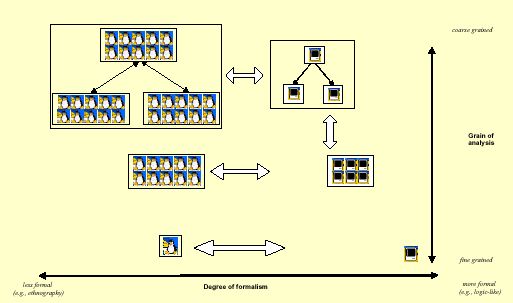| contents
| foundational ABSS: degrees of abstraction
| representational ABSS | description
as validation | relationship of validation
to declarative/imperative distinction |
foundational
and representational agent based social simulation
The
distinction between these is that foundational ABSS develops
tools, approaches and representations for representational
ABSS, while representational ABSS describes what we observe.
i)
foundational ABSS: degrees of abstraction
These
degrees of abstraction range from:
ii)
representational ABSS
This
describes target social systems. It complements qualitative
descriptions, and is less expressive than (say) ethnographic
studies. The relationships are expressed with less ambiguity.
 validation
and verification validation
and verification
-
Validation: determining whether a simulation model is a
"good" representation of the target social system
- Verification:
determine whether the model is consistent and sound with
respect to some formalism or other model or theory
validation
This
is concerned with relating models to target systems, and requires
criteria of goodness of the model. This is relevant to representational
social simulation, and raises the question of what is a "good"
representation of a social system.
There
is a choice to be made between two forms of validation, prediction
or description.
i)
Prediction as Validation
ii)
Description as validation
In
this case, validation is the demonstration that a model
is a "good" representation of its target system. Good means
telling the truth and nothing but the truth (though not
the whole truth). Furthermore, a good model has a subset
of the structure and some though not all of the relationships
of its target system
 description
and imperative modelling description
and imperative modelling
Imperative
modelling specifies processes. Process is inferred from
outcomes, and is hard to observe directly. It would amount
to direct observation of each step by each component. It
is an inherently and extremely fine grain activity
description
and declarative modelling
Declarative
modelling specifies behaviour: in conditions X, John does
Y. These conditions X need not be exhaustive; sufficiency
rather than necessity is important. It is easier to observe
whether John systematically does Y in some observable conditions
X than to observe everything everyone does during some social
process.
Relationship
of validation to declarative/imperative distinction:
| |
Imperative |
Declarative |
| Foundational
|
Game
theory
Sugarscape
Arthur's
el Farol Models |
BDI
approaches
Edmonds'
el Farol models |
| Representational |
vanAsselt
Rotmans Weissbuch/Images Doran's EOS models (?) |
Deontic
logic applications Moss' Critical incidents, transitional
economy models |
- Representational
verification
- This
models at coarser grains of representation and entail
agents whose behaviour emerges at finer grain.
-
Foundational verification
- Agent
behaviour sound and consistent with a chosen formalism
(eg BDI or deontic logic). Agent behaviour conforms
to experimentally validated theory of cognition

'top-down
and bottom-up'
-
The top is defined by the largest target system, such as
global, regional, national, catchment
-
The bottom less naturally defined, such as organisation,
department, individual, neurones
-
System development will develop different levels interactively;
but where is the bottom?
 validation
determines the bottom validation
determines the bottom
Declarative
agent-based modelling describes agents' actions in various
conditions of the system. The bottom of the system seems likely
to be determined by the fineness of grain at which stakeholders
or modelling teams can validate the agents as descriptions
of target entities (actors, departments, organisations). Independent
validation by stakeholders of simulated behaviour occurs at
more aggregated levels
|


